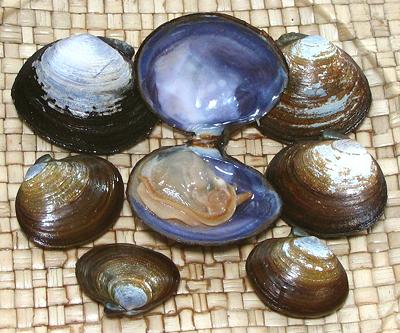 [Savory Clam (marketing); Purple Mahogany Clam, Dark Mahogany Clam;
Nuttalia obscurata]
[Savory Clam (marketing); Purple Mahogany Clam, Dark Mahogany Clam;
Nuttalia obscurata]
Native to estuaries of Japan and Korea, These clams were brought to Victoria Island, Canada around 1988, probably in ship's ballast water. They have spread north from there, and south along the northern coast of Washington State. A similar introduction now infests most of the coastal estuaries of the state of Oregon. They grow to about 2.75 inches measured the long way, but the largest of the photo specimens was 2.0 inches, weighing 0.88 ounce (25 gm). They are not currently farmed, but are harvested from high in the intertidal zone (above the Manilla Clam zone), where there can be more than 1400 clams per square yard.
More on Bivalve Mollusks.
Purple Varnish Clams have a good strong clam flavor and tender flesh, if not overcooked. Because they are smaller and lighter than Manilla clams, I consider them good for fancy seafood soups where whole live clams are included. Note: depending on harvest location, many of these clams can contain a parasitic Pea Crab. Do not be frightened, these don't harm the edibility of the clam, and many consider them a gourmet treat, raw or cooked. It is reported that George Washington liked them scattered over his oyster soup as a garnish.
These clams can be harvested recreationally in Washington and Oregon states, but check with the local fishery authorities about safety (they can retain shellfish toxins under some conditions), and mind the quotas.